Reviving a Large Ecosystem: ForestPlanet’s Strategic Reforestation Projects
We recently visited Tanzania, where two of ForestPlanet’s major tree-planting projects intertwine, offering a promising blueprint for environmental rejuvenation.
The Pangani River Basin in northeast Tanzania covers a total area of 56,300 square miles. The Irente Planting Site is located in the Usambara Mountain region, about 80 miles upriver from the Indian Ocean. The Pangani Village Planting Site is located right near the mouth of the river and dwells entirely within a tidal zone.
Starting with the Pangani Village Site, we’ll show how these two projects work together to address multiple social and environmental issues.
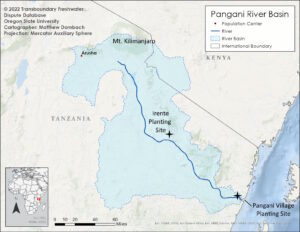
Return to Pangani
Pangani Village is an ancient fishing community where the Pangani River flows into the Indian Ocean. This is where ForestPlanet kicked off the East Africa Mangrove Restoration Project earlier this year, planting an initial 50,000 mangrove trees. Our local partners at the Friends of Usambara Society will plant a total of 400,000 mangrove trees at this site by early 2024.
This project is a cornerstone in re-establishing the mangrove populations critical to the region’s ecological and economic health. Our goal is as ambitious as it is vital: planting five million trees in the Pangani Village area by the end of 2025.
The Pangani River is a lifeline for the region’s wildlife, including fish, crocodiles, and various bird species. Its vast basin touches the lives of land and marine animals, underscoring the importance of a healthy mangrove population. These trees act as natural protectors, preserving water quality and providing habitat essential for the lower river’s biodiversity.

Mangroves: Nature’s Unsung Heroes
Mangroves are more than just trees; they are a complex ecosystem’s foundation.
- Their dense roots stabilize shorelines, preventing erosion and the silt runoff that can choke ocean coral.
- Their root systems are also the birthplace of fish, crabs, shrimp, and other marine species that contribute to the food and income autonomy of thousands of people.
- Mangroves sequester more CO2 than any other tree species.

At the Pangani Site, mangrove trees have been incrementally cleared in recent years, mainly by local inhabitants. The wood of this tree species burns well even if it is green, so there is no need to wait for it to dry out before using it to cook or heat a home. Also, the ocean-water salt absorbed into the wood fiber wards off termites, making it a desirable home construction material. Mangrove wood is also used in the construction of fishing boats.
Community Involvement Starts with Education
The true transformation at Pangani began with educating local residents through a series of town meetings and other gatherings. Local residents, now aware of the mangroves’ significance, have recently become their protectors. They understand the link between their actions and the health of the mangroves—and, by extension, their livelihoods. An initiative to monitor and protect these trees has taken root, with almost 10% of the community actively participating in safeguarding the mangroves’ future.
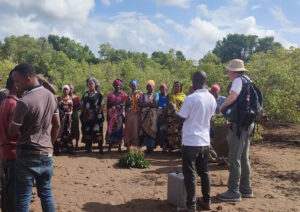
Getting to Work
There are ten planting site locations in the Pangani Village area, and the initial work focused on the biggest one: Pangani08. This area covers 149 hectares or about 368 football fields. This area has been a “bare spot” for years since the natural regenerative processes were thwarted by two major climate-related obstacles: damaged soils and an unreliable water supply.
The soil in this area contains a significant amount of clay, so repeated and prolonged exposure to higher temperatures and direct sunlight bakes the surface into a hard, cracked crust. To replant trees in this environment, workers must physically break through the crust with heavy pointed poles and then rotate down to get to soil levels that can absorb moisture. The holes must be deep enough for fresh rain and salty high-tide river waters to seep down and keep the transplanted seedling roots moist.
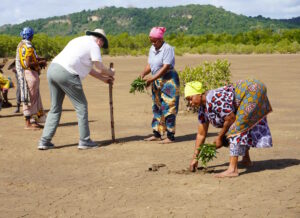
Multiple teams of people need to work together to get the seedlings planted: one group stretches out a long line running parallel to the previous row, one team measures out and marks spots along the line where the holes need to be created, another team moves down the line and bashes through the crust with a heavy pointed pole, and finally another team plants the mangrove seedlings with care and a little prayer.
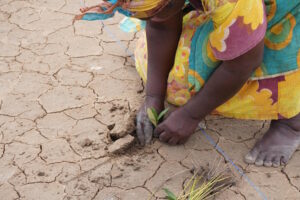
The process is repeated row by row until hundreds of thousands of seedlings are planted.
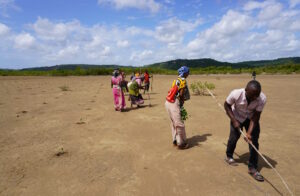
Water Reliability
In addition to the soil issues, there’s the challenge of a reliable water source. In recent years, the Pangani River levels have been too low for weeks at a time. River levels naturally fluctuate between the dry and rainy seasons, as well as with the lunar cycles. Even during “double-low” periods in the past—“small” high tides in the middle of a dry season—waters reliably reached well up and away from the riverbank. These tidal waters delivered sufficient moisture and nutrients to allow the mangrove root systems to survive and thrive.
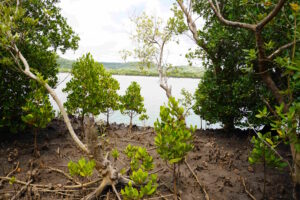
The above photo illustrates the precarious situation. This scene looks green and healthy, but the picture was taken at high tide towards the end of the dry season. On this particular day the water barely reached past the river bank, let alone into the tidal plane pictured above.
Human Intervention: A Necessary Force for Change
There are times when human intervention is essential to correct human mistakes. With natural regeneration hampered by various climatic challenges, proactive measures have become essential. These projects demonstrate that thoughtful, well-planned human action can positively impact the environment, leading to sustainable restoration.
The restoration of Tanzania’s mangroves is an example of resilience and community spirit. With your support, the region will see these vital ecosystems thrive again, benefiting the natural environment and the region’s people for generations to come.
***
In our next blog post, we’ll explain how the Irente Planting Sites affect the levels of the Pangani River, even at a distance of 80 miles. As discussed above, consistently high river levels lead to healthy mangroves, and healthy mangroves deliver environmental and social benefits. We’ll see how tree-planting projects far from the coast support these mangroves since they are all interconnected!

Hi Hank,
Thank you for drawing a clear picture of Forest Planet’s strategy and progress.
You and the people of the region are amazing.
Thank you for caring and putting the hard work in.